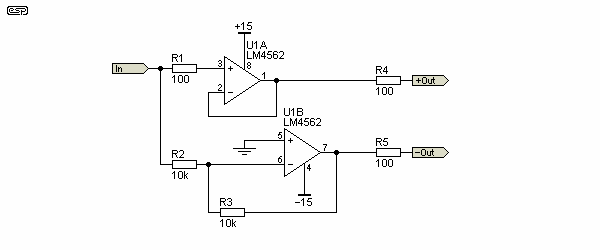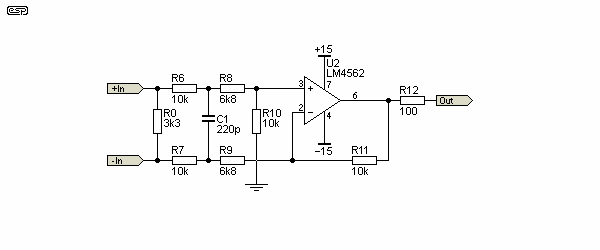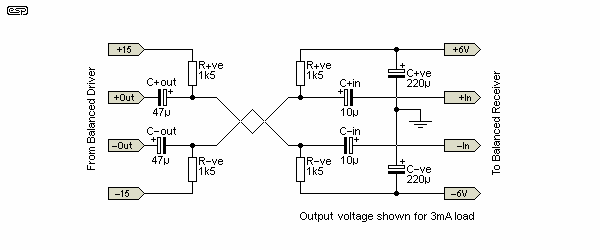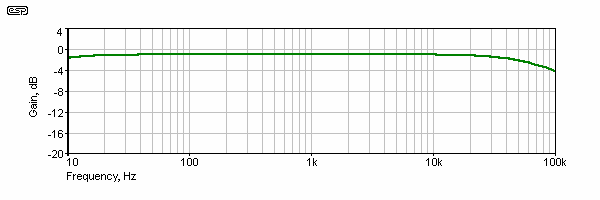

|
| Elliott Sound Products | Project 51 |
 |
PCBs are available for the updated version of this project (P87). Click the image for details. |
Sometimes, you just can't get rid of that %$#*& hum, no matter what you do. Especially with long interconnects (such as to a powered sub-woofer), earth loops can be a real pain. For this reason, just about all professional equipment uses balanced lines, which, if properly executed, will eliminate the hum completely. At least, that's the theory, but it doesn't always work as well as you may have hoped.
With this simple project, you can have balanced lines too, simply adapting the unbalanced inputs and outputs of your hi-if gear to become balanced, and then back to unbalanced at the other end. You can even be extra cunning, and power the remote converter from the cables carrying the signal. Professionally, this is called 'Phantom' power, and is used to power microphones and other low current equipment. The version I have shown is actually a differential feed. Whilst not as good as a true 48V phantom powering circuit, it does work, and makes an interesting experiment (if nothing else).
Note that balanced interconnects do not sound 'better' than traditional unbalanced connections unless hum is an issue that is solved by using balanced lines. Balanced connections are useful between separate units (preamp to power amp for example) when hum is experienced, but will make no useful difference if there is no hum. It is not necessary to use balanced connections from floating signal sources such as microphones, but it's common practice because these sources are traditionally balanced whether you need it or not.
The updated versions of the line driver and receiver are shown in Project 87.
Before we start, a brief description of the standard (unbalanced) and balanced line is in order. An unbalanced line is the type you have on the hi-if, typically using an RCA connector, and feeding the signal through a coaxial cable. The inner cable carries the signal, and the outer shield is a screen, to prevent RF interference and general airborne noise from being picked up on the signal lead.
This is fine, except for one small detail - the shield must also carry the signal! This is the return path, and is required in all electrical connections - otherwise there is no current flow and the system will probably just hum softly (or loudly) with none of the wanted signal.
The problem with electricity (like water and most people) is that it always takes the path of least resistance, so when two pieces of equipment are connected, most likely there will be signal plus hum, because of the dreaded earth loop. This is formed when both items are connected to the mains earth, and also have their earth (zero Volt) points joined via the shields of the signal leads.
In some cases it is possible to disconnect the earth at one end of the cable - some people have also disconnected the mains (safety) earth. Both achieve the same result, but disconnecting the mains earth is extremely dangerous. Unfortunately, the result is not always as one would hope. RF interference can become much worse, and other noises become apparent that were absent before.
In contrast, a balanced connection uses two wires for the signal (much like the telephone circuit), with the signal equal in amplitude in each wire, but opposite in phase. Only the out of phase signal is detected by the remote balanced receiver, and any in phase (common mode) signal is rejected. RF interference and other noise will be picked up equally by both wires in the cable and so will be in phase. It will therefore be rejected by the receiver. In this way, it is possible to have long interconnects, with the shield connected at one end only. This cuts the earth loop, and the balanced connection ensures that only the wanted signal is passed through to the amplifier(s).
It is very important that the two signal leads are twisted together, and the tighter the twist, the better. The shield prevents RF and other interfering signals from causing too much trouble, and the final signal should be free from hum and noise. The shield serves the same function in an unbalanced circuit, but is less effective due to the fact that it usually serves as the signal return path, and any signal that does get through becomes part of the signal.
The idea of this project is to give you some options, and to assist in creating a solution - it should not be seen as a complete solution in itself. There are many variables - far too many to be able to say with complete confidence that this WILL prevent all hum and other interference. It might, but it is likely that some experimentation will be needed to get the results you want.
Note that for both transmitter and receiver, it is essential that 1% (or better) tolerance resistors are used. If you include a trimpot to allow trimming to obtain exact gain then you could use 5% resistors, and you will be able to adjust the circuit to get maximum common mode rejection - however I recommend that you use the 1% metal film resistors. For the small extra cost you get much higher stability and lower noise.

The transmitter uses one opamp to buffer the signal, and the other to buffer and invert it. This creates a balanced signal, where as the signal swings positive on one lead, it swings exactly the same amount negative on the other. The 220 Ohm resistors at the output ensure stability with any lead, and are also used to attenuate the signal slightly. The signal swing from the transmitter (across both wires) is double the voltage of the input signal.

The receiver has an optional 3.3k resistor across the inputs (RO) to help balance the input against minor variations in cable impedance between the individual lines. The 220pF capacitor is for HF rolloff, and will attenuate any RF that might get picked up by the lead. Any common mode signal - where both leads provide a signal of the same polarity to the receiver circuit; typically noise - is rejected, leaving only the wanted signal.
The rest of the circuit is a conventional balanced input stage. This particular configuration is somewhat notorious for having unequal input impedances referred to earth. The 3.3k resistor helps this (a little, anyway), and the 220pF capacitor also assists at higher frequencies. A more complex circuit (known as an instrumentation amplifier) could have been used, but that would require 3 opamps, and for the intended task would offer few real advantages. Interestingly and perhaps unexpectedly, the unequal impedances don't create a problem in 99% of cases.
With the capacitor value chosen, there is about 0.2dB attenuation at 20kHz - if you don't like this idea, reduce the value to 100pF. Since 0.2dB is normally inaudible, there seems little point, especially if the circuit is used in a powered sub for example. In that case, there is a benefit if the value is increased - 10nF will reduce the -3dB frequency to 1.9kHz.
With the values shown, there is a very slight overall gain (transmitter + receiver) of just under 1.3dB. This is unlikely to be a problem. The circuit is designed to send the maximum level possible across the balanced cable, and any attenuation should be performed at the receiver. This will reduce any noise picked up by a useful margin. If you need to change the gain, then both R10 and R11 need to be changed - they must be exactly the same value. For example, increasing both to 15k will provide an overall gain of 4.8dB and reducing both to 4.7k will give an overall gain of about -5.3dB.
It is also possible to ensure that the common mode rejection is as good as it can possibly get, by making R10 variable. I suggest that you use an 8.2k fixed resistor, with a 5k multi-turn trimpot in series. To balance the circuit, you simply use an oscillator and millivoltmeter (or just a AA cell and a multimeter because the circuit as shown is DC coupled). When perfectly balanced, the output will be zero (AC/DC). You might want to limit the range of the trimpot further, because it is very sensitive. With the 10k resistors as shown, a change of just 10 ohm is easily measurable. Common mode rejection will be around -68dB with a 10 ohm resistor mismatch. 1% resistors can have a mismatch of up to 100 ohms, so it's apparent that the resistor tolerance is critical.
If R10 is paralleled with 390k the resistance is then 9.75k, and a 500 ohm multi-turn trimpot can be used in series. The total variation is now reduced to ±250 ohms (±2.5%), so you must use 1% resistors, and preferably match them with a multimeter. It will still be sensitive and a little difficult to adjust, but you should be able to get the CMRR up to 80dB with care.
Join the two inputs together, and connect the battery or audio oscillator between the two joined inputs and earth. Adjust the trimpot until there is 0V at the output - the common mode signal is now gone completely. Typically, this circuit will give a common mode rejection of about 40dB if not trimmed as described, but trimming will let you improve on this considerably. In theory, the rejection is infinite, but expect 80dB or more if the resistances are balanced to within 1 ohm. I have tested and verified this using an NE5532 opamp, and better than 80dB CMRR is possible - albeit very critical to adjust.
Although this transmitter and receiver pair will probably allow the use of unshielded interconnects, I don't recommend this. Use a good quality shielded twin microphone cable. The earthing of the shield should normally be done at the receiver end, but in some cases you might find that the noise rejection is better if the transmitter end is earthed. Experimentation will be needed, and often both ends will be earthed. One trick that often works well is to connect the 'floating' end of the shield to earth with a 100nF multilayer ceramic capacitor.
It is possible to run this unit with the signal leads also carrying the power for the receiver. We could use conventional phantom feed (using a 48V supply), but it is easier to use a differential feed, with the +ve and -ve supply voltages on the signal leads. The basic scheme is shown in Figure 3. This may be found to reduce common mode rejection, and it is essential that the power is completely noise free, or it will become part of the signal! If this method is to be tried, use the trimming option so the supply feed resistors can be catered for. Alignment with a battery will no longer be possible, and a signal generator will have to be used - with coupling capacitors to each signal line.
 |
The resistor R0 must be removed in this configuration. I would strongly recommend that an output coupling capacitor is used from the Out terminal of the receiver, since it is likely that there will be some DC offset due to capacitor leakage currents. |

The voltage to the receiver opamp is reduced by this technique, and the maximum signal level will be reduced too. Only by experimenting will you be able to determine the exact power losses and maximum signal level attainable. The tests I did indicate that you should not expect more than about 1V RMS, but you might get more depending on the opamp used for the receiver. The power feed resistors also load the transmitter, and reduce its output capability somewhat. You will have to use NE5532 or OPA2134 opamps to drive the circuit because of the low impedance load. Each driving opamp has an effective load of less than 750 ohms.
You will also want to experiment with a low-power opamp as the receiver, as this will allow a higher supply voltage and more signal before distortion. As shown, the output voltage assumes a 3mA load. I strongly suggest that you do not use a TL072 for the receiver, because they don't like low voltages and the source can easily overdrive the inputs. All TL0xx series opamps suffer from an output polarity inversion if the common mode voltage limit is exceeded.
Note that the value of the 1.5k resistors is just as critical as those around the opamps. They should be matched to 0.1% or better or common mode performance will be compromised.
The shield will now have to be connected at each end, but one end can be earthed using a 10 Ohm resistor, which should be bypassed with a 100nF capacitor. Again, experimentation is needed to determine which end should have the 'hard' earth. Make sure that the connectors are polarised so that power cannot be connected the wrong way around. Diodes may be added if desired to provide reverse-polarity protection. These should be in parallel with the receiver filter caps (C+ve and C-ve), because a series connection will reduce the voltage further (there is not a lot to start with, so a further reduction would be inadvisable).

The response graph shows the measured frequency response with the differential feed, a balanced line driver (Figure 1) and receiver (Figure 2). The signal is 1dB down at 10Hz and 30kHz, which is pretty good considering the overall simplicity of the circuits.
I would expect that the most likely use for this arrangement would be for a remote sub-woofer, where it may be very inconvenient to have to create an additional power supply. I can't say that I am completely happy with this arrangement, but it does work. A 48V phantom supply would be better, but it is not likely that too many constructors will want to go to that much trouble. Standard P48 phantom feed also has very limited output current.
Use of a multi-cored cable and suitable connectors will allow you to run the power supply on separate wires in the cable, and the additional cost of the cable and connectors is likely to be offset by the simpler circuit and better performance. This may not always be possible, hence the differential feed. Note that this is not the same as phantom feed, and must not be used in an attempt to drive phantom powered microphones.
 Main Index Main Index
 Projects Index Projects Index |